- Home
- The Winter Garden
- Winter Berries
Brilliant, Persistent Winter Berries on Shrubs and Trees Provide Color and Beauty in the Garden.
The appearance of winter berries on shrubs or trees is one of the charms of the season. Whether covering a plant or peeking through the leaves, they lend color to the garden when most everything else is gray or brown, provide food for birds, and make for readily obtainable natural Christmas decorations. Hollies come first to mind for berries. There are red, black, orange,yellow and white-fruited types, evergreen and deciduous ones.
I am presently nandina-less, but I would love to be able to go out to the garden and pick the large clusters of red berries for wreaths and garlands—guess I better plant some! Depending on where you live, there are shrubs and trees that will suit your climate and reward you with winter color and beauty. Here is a list of some of the possibilities. I have listed mostly the species. Check with your local nurseries for specific cultivars that are best for your area.
Arbutus menziesii, Pacific madrone, Zone 7—tree with red fruits that persist into winter
Ardisia japonica, Japanese ardisia or marlberry, Zones 8-9—evergreen ground cover for shady situations, produces persistent red winter berries. 'Chirimen' is shown below.
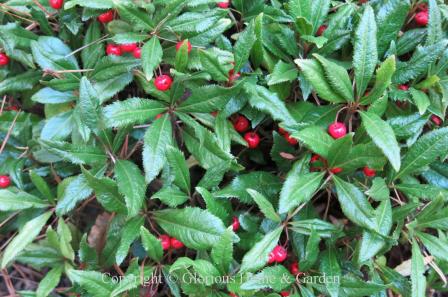 Ardisia japonica
Ardisia japonicaAronia arbutifolia, red chokeberry, Zones 4-9—shrub, bright red fruits persist into winter
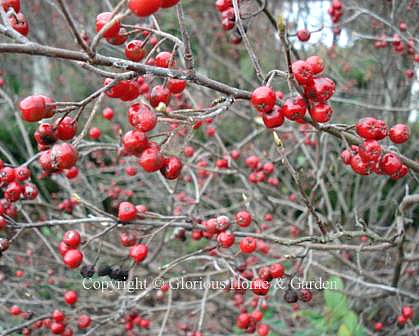 Aronia arbutifolia
Aronia arbutifoliaAucuba japonica,, Japanese aucuba, Zones 7-10—shrub, red fruits persist to spring
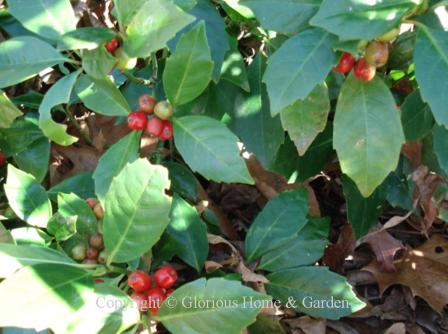 Aucuba japonica
Aucuba japonicaBerberis koreana, Korean barberry, Zones 3-7—shrub, red berries persisting into winter
Berberis thunbergii, Japanese barberry, Zones 4-8. Barberries are often used for hedges and barriers due to their thorns, but the red berries produced in the fall are decorative and are good food source for birds in the winter. 'Kobold' is shown below.
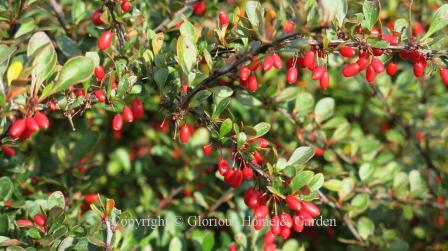 Berberis thunbergii 'Kobold'
Berberis thunbergii 'Kobold'Cornus florida, flowering dogwood, Zones 6-9—tree, bright, ornamental red berries persist into winter, but are usually eaten by birds and gone by spring. Also, the fat flower buds that appear in late fall are ornamental throughout winter reminding one of the show to come.
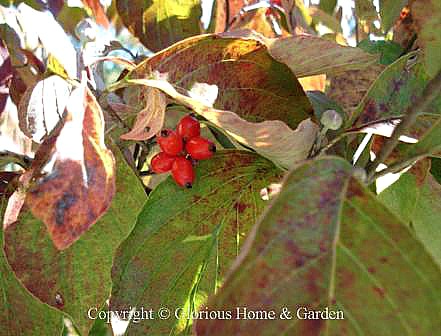 Cornus florida
Cornus floridaCrataegus phaenopyrum, Washington hawthorn, Zones 4-8—tree, bright red clusters of persistent winter berries
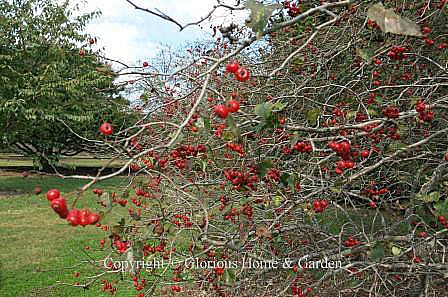 Crataegus phaenopyrum
Crataegus phaenopyrumGaultheria procumbens, creeping wintergreen, Zone 3-6—ground cover, red fruits persist until spring
Hippophae rhamnoides, common seabuckthorn, Zones 4-7—shrub, orange fruits persist through winter
Holly Berries
Ilex cornuta, Chinese holly, Zone 7-9—evergreen shrub or small tree, large round red berries persist through winter. Common cultivars like Burford, Carissa and Needlepoint are in this group. There are some yellow-fruited varieties. I. cornula d'Or is shown.
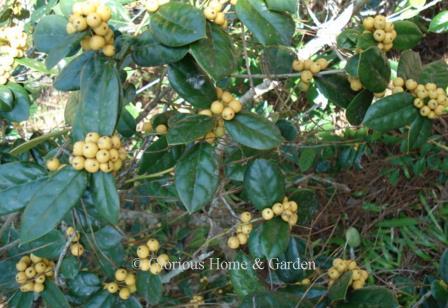 Ilex cornuta d'Or
Ilex cornuta d'OrIlex glabra, inkberry holly, Zones 5-9—shrub, black fruits persist a long time
Ilex opaca, American holly, Zones 5-9—evergreen tree, persistent red winter berries contrast with spiny green leaves.
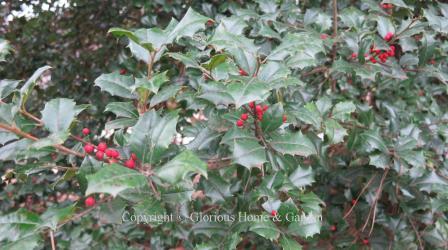 Ilex opaca, American holly berries
Ilex opaca, American holly berriesIlex verticillata, winterberry holly, Zones 3-9—shrub or small tree. This deciduous holly is usually very heavily loaded with red winter berries. Can be spectacular in late fall to mid-winter landscape before the birds strip the plants. Must use a male pollinator.
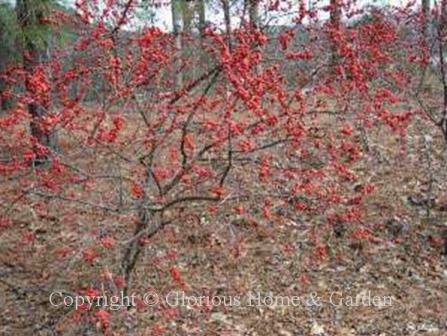 Ilex verticillata
Ilex verticillataIlex vomitoria, yaupon holly, Zones 7-10—evergreen shrub or small tree, small red fruits are abundantl. Weeping varieties are particularly nice as specimens. Native to the Southeast U.S.
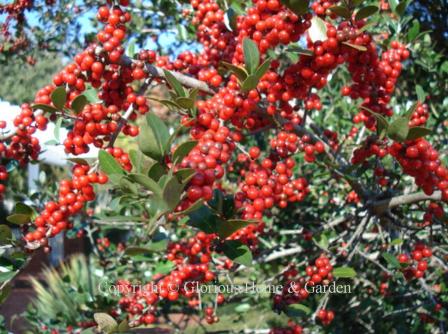 Ilex vomitoria
Ilex vomitoriaLigustrum japonicum, Japanese privet,Zones 7-10—shrub, small black fruits persist through winter
Malus ‘Autumn Glory,’ ‘Donald Wyman,’ ‘Harvest Gold’ ‘Ralph Shay,’ M. sargentii, ‘Sugar Tyme,’ crabapple, Zones 4-7—tree. There are many types of crabapples. These are a few reputed to have abundant fruits lingering through winter and good disease resistance.
Morella cerifera, wax myrtle, Zones 7-11. Evergreen shrub or small tree, the bayberry of the South, small grayish waxy fruits persist until birds eat them. I have seen a flock of cedar waxwings strip a shrub no time! Also known as Myrica cerifera.
Morella pensylvanica, bayberry, Zones 3-6. Shrub, the small grayish waxy fruits persist through winter until the birds eat them. Famous for its scent used extensively for making fragrant soaps and candles, bayberry also makes an attractive garden hedge. In the wild, it is commonly found at the seashore where it withstands strong winds and salt spray. Deciduous to semi-evergreen. Also known as Myrica pensylvanica.
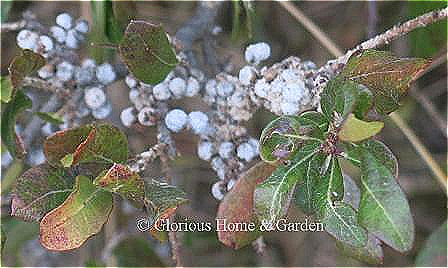 Morella pensylvanica
Morella pensylvanicaNandina domestica, nandina, Zones 6-9—shrub, produces large, showy, heavy panicles of berries that persist through winter. Great to have for Christmas decorations, however, can be invasive in some areas.
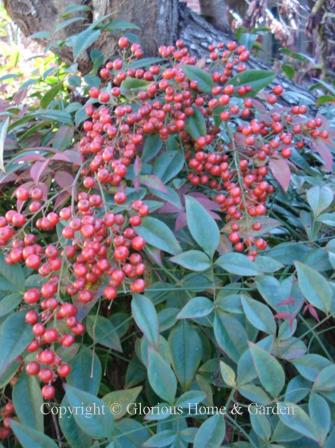 Nandina domestica
Nandina domesticaPyracantha coccinea, scarlet firethorn, Zones 6-9—shrub, produces abundant bright scarlet red fruits. Makes a good espalier subject on a wall—beware of thorns.
Pyracantha koidzumii, Formosa firethorn, Zones 7-10. Spectacularly heavy production of red berries on a large shrub or small tree that can reach 20'. 'Victory,' shown below, is more likely to reach the 10-12' range. Great for fall and winter color. Thorny!
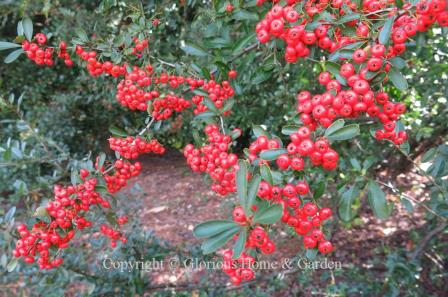 Pyracantha koidzumii
Pyracantha koidzumiiRhaphiolepis umbellata, Indian hawthorn, Zones 7b-10—shrub, blue-black fruits persist
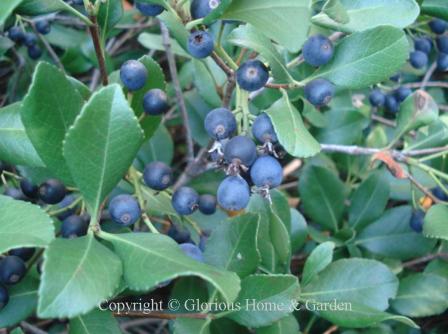 Rhaphiolepis umbellata
Rhaphiolepis umbellataRohdea japonica, Japanese sacred lily, Zones 5-9. Japanese sacred lily is a good choice for a woodland garden with dry shade conditions. It is evergreen and has long, narrow strappy leaves, insignificant flowers and bright red berries which make a nice show in winter. Best grouped together en masse for the best display.
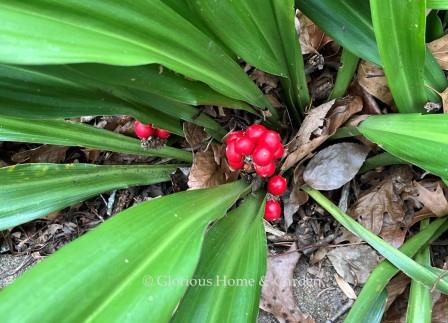 Rohdea japonica
Rohdea japonicaSkimmia japonica, Japanese skimmia, Zones 6-8—shrub, bright red persistent fruits follow the flowers at the tips of branches—very showy.
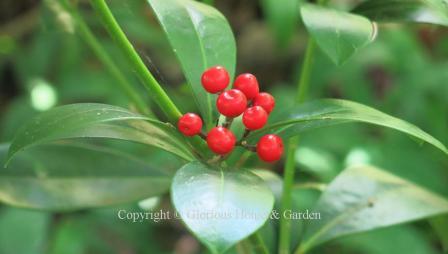 Skimmia japonica 'Highgrove Redbud'
Skimmia japonica 'Highgrove Redbud'Viburnum dilatatum, linden viburnum, Zones 5-7—shrub, excellent red fruit color. 'Asian Beauty' hand 'Cardinal Candy' are two good cultivars that hold their color well through the winter.
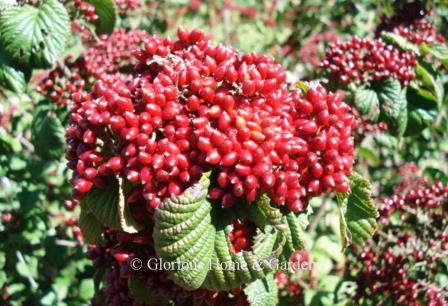 Viburnum dilatatum 'Cardinal Candy'
Viburnum dilatatum 'Cardinal Candy'Viburnum opulus, European cranberrybush viburnum, Zones 3-8—shrub, red fruits persist through winter
Plant of the Month
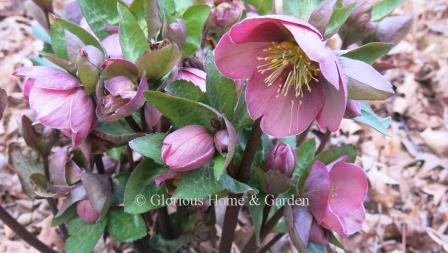
Helleborus x iburgensis
'Pippa's Purple'
Updated new USDA Plant Hardiness Zone Map 2023.